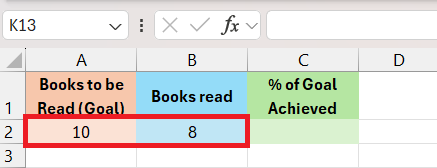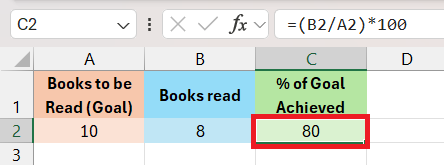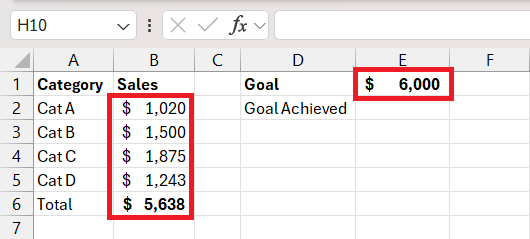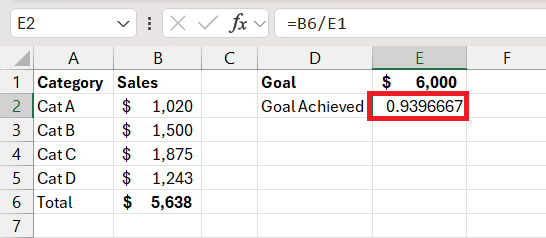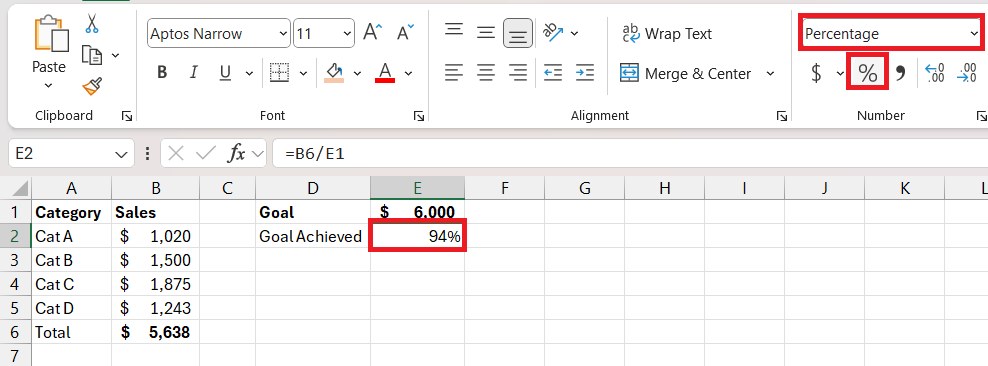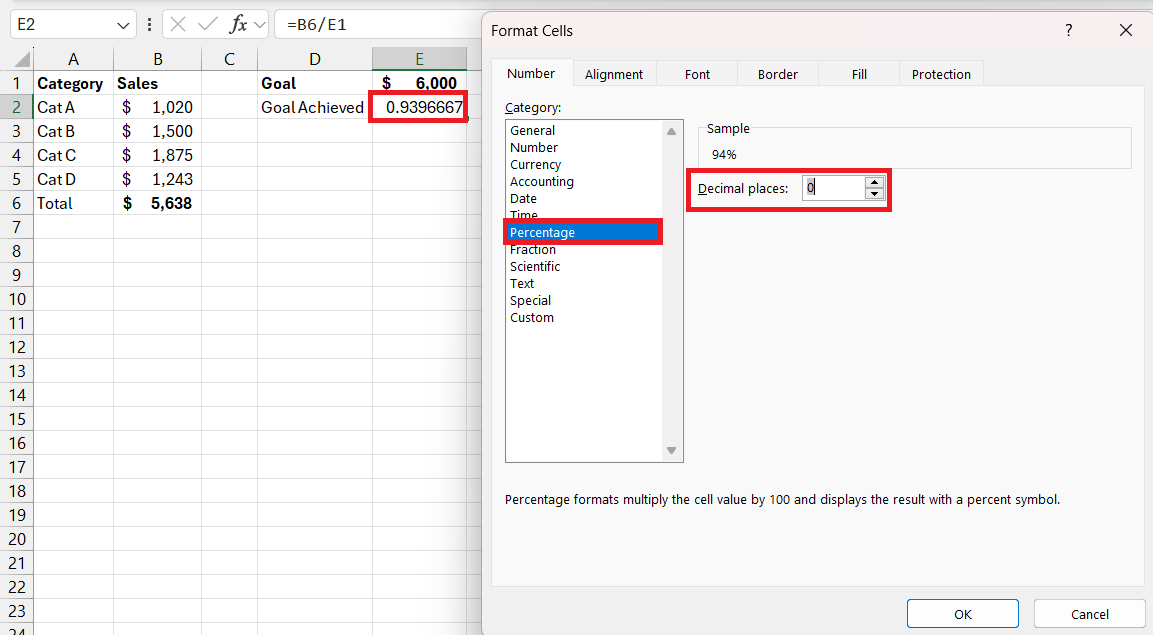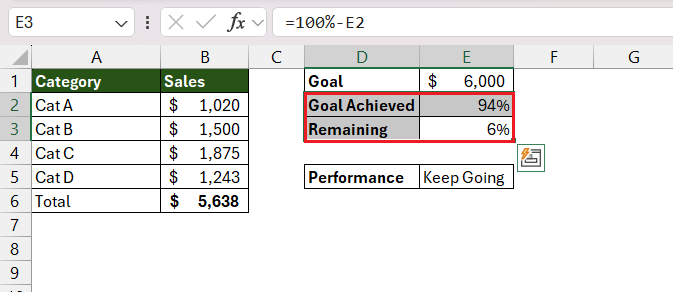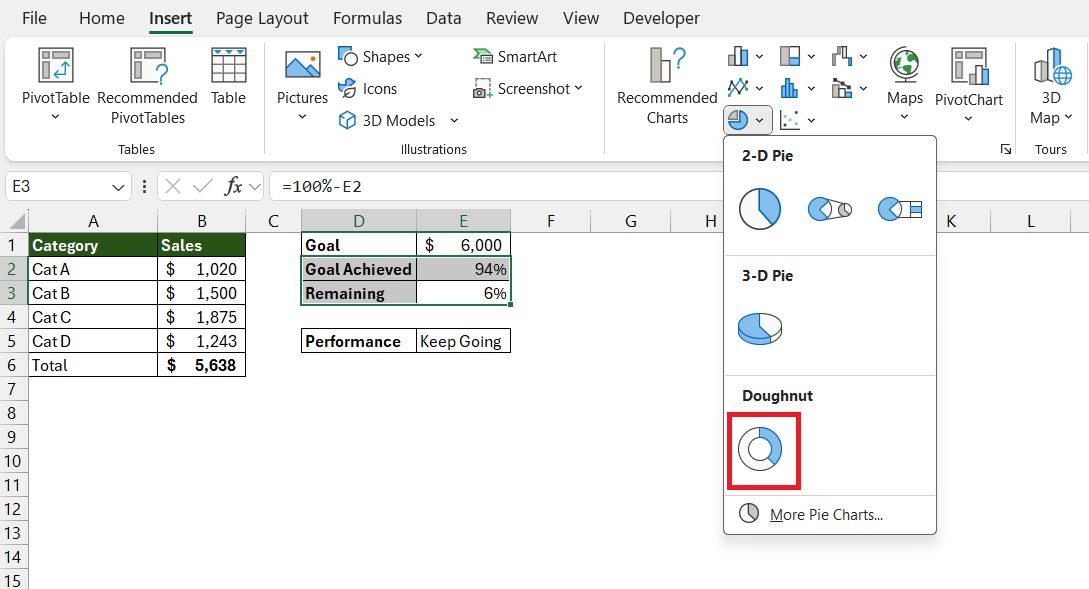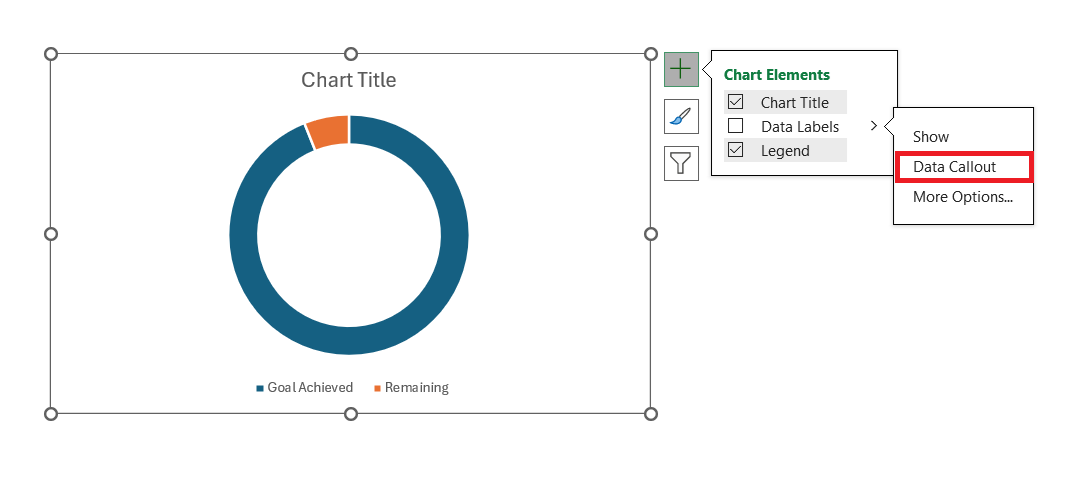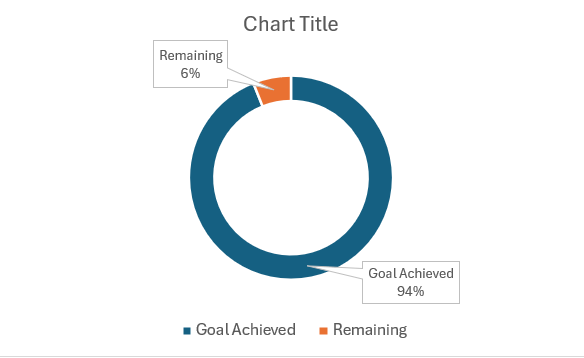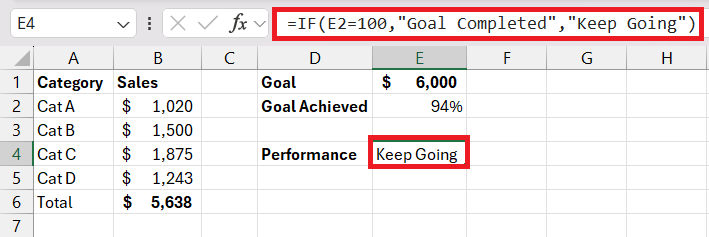Calculating the percentage of a goal achieved is a straightforward process that can be efficiently performed in Microsoft Excel. By using a basic formula, you can quickly determine how well you are tracking toward your targets, be it in sales, budgeting, or project milestones. This functionality turns Excel into a powerful tool for monitoring progress and assessing performance against set goals.
Key Takeaways
- Excel percentage of goal formulas are essential for effective data analysis and management.
- Mastering quick calculation techniques saves time and improves decision-making.
- Setting quantifiable goals in Excel is crucial for guiding strategic moves.
- Automation features and troubleshooting tools help streamline calculations and resolve errors efficiently.
Download the workbook and follow along with the tutorial on How to calculate the percentage of goal in Excel – Download excel workbookPercentage-of-goal-in-Excel.xlsx
Table of Contents
Introduction to Excel Percentage Calculations
Understanding the Basics of Excel Percentage Formulas
Excel’s built-in tools for calculation enable you to perform a variety of essential business computations efficiently. When it comes to tracking progress and performance, percentages often come into play. Let’s get to grips with the basics of Excel percentage formulas to help manage and analyze data effectively.
The Importance of Mastering Quick Calculation Techniques
Time is a non-renewable resource, especially in a fast-paced work environment. Mastering quick calculation techniques in Excel is not just a time-saver; it can also dramatically improve your data analysis skills. Accurate and speedy calculations ensure that decision-making is informed and timely, helping to steer projects, financial decisions, or marketing strategies toward successful outcomes.
Setting Your Goals in Numbers
Defining Your Target Metrics for Success
To pave the road to success, one must know the destination. In Excel, your first step is defining your target metrics. These quantifiable measures act as milestones, ensuring that goals aren’t just wishes but planned achievements. From sales figures to customer engagement rates, every metric will serve as a beacon, guiding your strategic moves and adjustments.
Translating Business Objectives into Quantifiable Goals
Once business objectives are shaped into clear visions, the challenge is translating them into measurable elements. Quantifiable goals convert abstract aims into concrete numbers. This could mean setting a revenue target, a specific number of new client acquisitions, or a desired percentage increase in productivity. Excel is the perfect canvas to paint these numbers, preparing them for the analytical journey ahead.
Step-by-Step Guide to Calculate Percent of Goal Achieved
Example 1: Simple Percentage of a Single Goal Calculation
Let’s break it down with an example where ease meets efficiency. Suppose your goal is to read 10 books in a year, and you’ve read 8 so far, so 80% of goal is acheived. To calculate the percentage of a single goal, follow these steps with an example:
STEP 1: In cell A2 mention the goal of books to be read and in cell B2 mention the number of books read. So for example, it will be 10 in cell A2 and 8 in B2.
STEP 2: In cell C2 enter the formula ” “. This formula divides the goal achieved (B2) by the total goal (A2) and then multiplies by 100 to convert the result into a percentage.
STEP 3: Press Enter: After typing the formula, press the Enter key on your keyboard. Excel will calculate the percentage and display the result in the selected cell (C2).
Example 2: Cumulative Goal Progress Across Multiple Parameters
Consider tracking cumulative goal progress across various parameters for a more complex scenario. For example, if your goal is to achieve a certain number of sales across different product categories, you can sum up the actual sales of each category and compare it against the overall sales target. Let’s follow these steps with an example:
STEP 1: Cells B2 to B5 represent actual sales for each category, and E1 is your total sales goal, your Excel setup might look like this:
STEP 2: In cell A6, you’d calculate the sum of sales with =SUM(B2:B5). In cell E2, you’d calculate the percent of the total goal achieved with =B6/E1.
STEP 3: After setting the percentage format for E2, you instantly see the overall progress toward your sales goal. To format it as a percentage, after selecting the relevant cell (E2) either do the following:
- Go to the “Home” tab in the Excel ribbon, click on the “Percentage” button
- Right-click on the cell, select “Format Cells,” choose “Percentage” from the Category list, and set the desired number of decimal places.
Customizing Your Excel Dashboard for Goal Tracking
Visualizing Progress with Charts and Graphs
A picture is worth a thousand words—or in this case, a thousand data points. Visualizing progress using Excel charts and graphs turns complex data into digestible visuals that communicate the story behind the numbers.
A Doughnut chart, akin to a pie with a hole in the middle, is particularly effective for showing progress towards a goal. You can customize it to highlight the percentage of goal reached with vivid colors, and even insert the achieved percentage in the center for immediate clarity.
Follow the steps below to add a doughnut chart in Excel –
STEP 1: Select the data range that you want to include in the chart.
STEP 2: Go to the “Insert” tab > “Insert Pie or Doughnut Chart” > “Doughnut” from the dropdown menu.
STEP 3: To customize the chart, click on it and select the + sign. Click on Data Labels and select Data Callouts.
The doughnut chart is now ready.
Automating Calculations Using Excel Functions and Features
To become an Excel power user, lean on the application’s capability to automate calculations. Take advantage of functions like SUM, AVERAGE, and IF to streamline complex computations. Pivot Tables can help you manage and summarize large datasets, while features like Name Ranges can make your formulas more readable and easier to manage.
For example, an IF function can be used to automatically compare actual performance against goals and return custom messages like “Goal Completed” or “Keep Going.” This kind of automation saves time and reduces the risk of human error in your calculations.
Troubleshooting Common Issues in Goal Calculation
Addressing Rounding Errors and Precision Concerns
Minor discrepancies can arise from rounding errors, especially when dealing with large datasets or financial figures where precision is key. In Excel, you can tackle these by setting the cell format to display an appropriate number of decimal places, ensuring that your data reflects precise values.
Moreover, you can employ functions like ROUND, ROUNDUP, or ROUNDDOWN to control how numbers are rounded in your calculations, depending on the level of accuracy required for your analysis or reporting.
Resolving Formula Errors and Reference Mistakes
Even the most experienced Excel users might occasionally confront the dreaded #REF! or #VALUE! errors. Typically, these errors result when cell references are incorrect, or when a formula expects a different data type.
To resolve these, double-check that your formulas reference the correct cells. If you’re using a function, make sure all required arguments are in place and of the correct type. The ‘Trace Precedents‘ and ‘Trace Dependents’ features are invaluable tools for identifying where your formulas are pulling data from and where they feed into.
FAQs
1. How do I calculate the percentage of a goal in Excel?
To calculate the percentage of a goal in Excel, use the formula =Actual/Goal in a cell, where Actual is the achieved value and Goal is the target value. Format the cell as a percentage for a clear display of progress.
2 .What is the percentage to goal if the progress value is 20 and the goal is 400?
If the progress value is 20 and the goal is 400, the percent to goal is 5%. Calculate this by dividing the progress (20) by the goal (400) and then multiplying by 100.
3. How do you calculate 25% progress towards a goal in Excel?
To calculate 25% progress towards a goal in Excel, multiply the goal amount by 0.25. For example, =Goal*0.25. This will give you the value representing 25% of your goal.
John Michaloudis is a former accountant and finance analyst at General Electric, a Microsoft MVP since 2020, an Amazon #1 bestselling author of 4 Microsoft Excel books and teacher of Microsoft Excel & Office over at his flagship MyExcelOnline Academy Online Course.

